Master in City & Technology 2019/20 – Term III
Seminar Name: Urbiotica – From PSC to ISP (From Permanent, Simultaneous & Collectives, to Intermittent, Successive & Personal urban experiences)
Total Hours: 20 hours
Faculty: Willy Müller
Faculty Assistant: Camila Alvarez
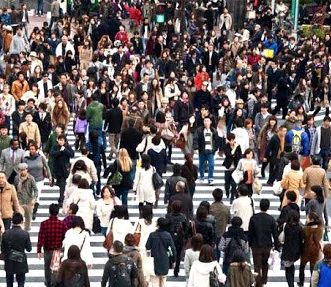
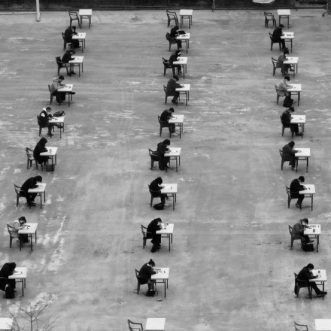
Syllabus
The current situation of crisis throughout the Planet forces us to make a reflection as an educational community.
It is a part of our experience at the IAAC to develop visions about the future of the urban scale, which can be imagined in a very experimental way, how habitats in which we will live shortly will look like and how they should be organized. This is why a crisis of this type, which directly affects the whole urban ecosystem in general, should be understood by the entire academic community as an opportunity.
We believe that one of the victims of this global crisis is specifically the city, as a public space to share, to communicate and to expand our life experience in every way; and these days we are suffering a reduction until almost disappearance of all this public space replacing the square by the shared screen, the face-to-face talk by the shared audio, or our 360º vision by the fixed point of the camera.
All our experience of teaching and learning is being put into stress: from learning by living of our immersive research lines in overcoming learning by doing, to learning in my living (room) today: re-education of habits, new synchronies and scenarios, adaptation of formats and scales to the size of our new vision on a laptop, iPad or a smartphone screen.
But, what will happen to our cities?
In the history of Architecture, there have been different visions of this same problem, from the bunker cities faced with the threat of a nuclear war, to biosphere cities as the iconic image of Buckminster Fuller’s dome over New York to protect us from environmental threats. Or on another scale, from the suggestive images for science fiction movies created by Syd Mead*, to the developments of design and prototypes to create a community on Mars.
From our bodies to the city, a sequence of absolutely strategic dissolved scales for all of us who teach and work in the field of expanded design.
From the IAAC we teach our students to develop the skill for rapid switch between zoom-in and zoom-out: the ability of scales’ shifts, between bits and geographies, or, more closer to our body in the extraordinary circumstances we live in: the ability of the retina to adapt to different fields of light, at different depths of field. We normally experiment with known elements for specific situations that will occur in the future. Now we expect you to experiment with ideas of the future for an extremely real situation.
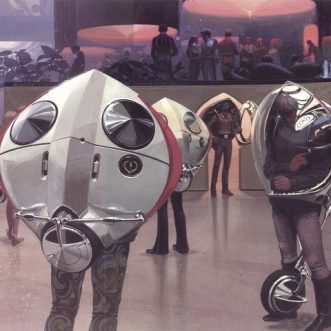
SYD MEAD, UNI-POD, A personal transport design.1969.
One of the most critical aspects of the global impact of this Pandemia, like the one we are experiencing, has as its stage our most successful invention as a society, our cities.
In recent days, we have collectively exercised a drastic compression of our space-time, in a zoom-in, zoom-out -zoom.us could be the most descriptive and paradigmatic reference of these times-, connected from our room to multiple rooms in the world, from our screen to multiple screens, microphones and cameras with which we are sharing globally the grade of intimacy never seen before, but above all, when the effervescent effect of hyper-communication is over, we will have transferred to this virtuality at least three phenomena that distinguished real from virtual spaces: the permanent, the simultaneous and the collective.
Three concepts that have undoubtedly defined our urban experience from generation to generation, and that an unexpected accidental castling has made them reversible as a Bomber jacket – whose original orange lining was specially designed in the aviation industry so that pilots could put it on in case of an accident in order to be rescued.
We still live in the shock of an accident, and in that dramatic space of the moment after something that we begin to understand, and the moment before knowing what has happened to us. A major accident, global and with multiple consequences on our personal and collective habits and customs, but which, like the reversible lining of a Bomber jacket, forces us to re-adapt to a new normality, to assume collapse and try to survive.
If we have transferred to virtuality the idea of the permanent – spatially and temporarily – of the simultaneous – all at the same time – and of the collective – all together -…,
What will our city become?
The accident always places us in a point of suspension, between something and something, into the concept of the inter.
We are witnessing, with confusion and fascination, the desolated images of any great avenue of the planet normally collapsed, we also see the irremediable regeneration action of nature that always reminds us that the planet will not come to the end, but only our presence in it, and we are getting used to unforeseen phenomena, such as the luxurious necessity of a balcony, or the surprising importance of the facade in front and its neighbors, with whom we live, see and share applauses every day, more than with any other people in our staircase or building. New friends.
But the city, as a collective idea of organizing the flow and time of social activities in public space, has been suspended, has been left in suspension.
There couldn’t be a better definition since we imagined a greater reliability of the entire system on which we placed the trust to use it. It is paradigmatic that many of the values with which we build coherent arguments of urban management have disappeared at once. We are in the inter, after an accident, but we do not know how to manage the city in the right way in these circumstances.
It could be said that, independently of the collapse of the health system, -impossible to foresee in these magnitudes-, in strictly urban terms, we should not have been so unprepared, after all the over-acting during many years of the intelligence applied, smart cities, and the shift of the old ratios in stock, – typical of the industrial era with which we planned the metropolis, to the management of dynamic data, with the real time data come every three seconds with which we have re-learned how to forget more than remember them.
What a mistake! We are not able to manage a simple mathematical formula for rational use by age ranges and temporal spaces, by neighborhoods, by density, or by the many parameters for which we have invested time and money to determine. We also don’t see the Jeff Bezos’ drones fly that made Amazon an empire, while we have airports shut down, and the ease of being able to organize reliable, clean, and effective deliveries should be part of the acceleration logic in a change of epoch within these circumstances.
The city, if it has an opportunity to be used, is to change radically now in order not to have to change absolutely later. Today’s city, of inter, of suspense, is of the orange side jacket.
Intermittent, Successive, Personal.
We have enough intelligence to manage it that way, restoring collective confidence in a system to survive in the interim, in the temporality of shock. The debate on the degrees of individual freedom that we are capable of sacrificing or in the opposite direction, the concentration of many personal details in a few hands, completely acceptable and necessarily active, should not become an excuse since we have delegated absolute responsibility and Awareness in many of our “I accept” on the web infinity of personal data. Confidence will come if there is a plan if there are leaders willing to guarantee it, and there is efficiency in its execution.
At the end of the day, belonging to a city is being able to use it, in the most convenient way at all times for its own citizens. And perhaps there will be some good news: perhaps the most favored are the neighborhoods that have the most green and open areas near their homes, traditionally on the outskirts and less favored in many other things.
This is the city of the orange side.
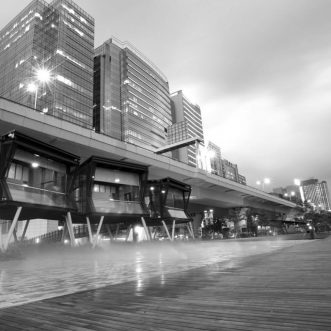
Kwun Tong Bypass situated on Hoi Bun Road /Hong Kong.
Faculty
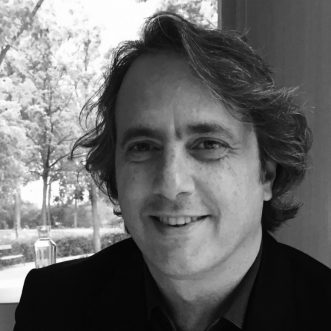
Willy Müller, Faculty.
– co-Founder IAAC, Institute of Advanced Architecture of Catalonia.2003
– Director Urban Sciences Laboratory IAAC (since 2015).
– Director X-UrbanStudio,Master Advanced Architecture IAAC 2003/18
– General Manager Rio de Janeiro Metropolitan Master Plan. 2016/18
– Former CEO Barcelona Regional Agency, BR, 2011-2015
– Former Development Director IAAC, 2003/2007.
– Member Board of Trust IAAC Foundation (since 2003).
– Founder WMA-Willy Müller Architects SLP ( since 1996).
– Visiting Professor Sci_Arc, Los Angeles, USA ( since 2017).
– Director Operaçoes Urbanas Consorciadas,Fortaleza, Brasil 2017/18
Born in Argentina, he obtains his architecture degree in the National University of La Plata. In 1985, he settles in Barcelona where he attended doctorate courses in the Escuela Técnica Superior de Arquitectura de Barcelona (ETSAB).
In 1997, he founded and directed Metapolis group, along with Vicente Guallart and Manuel Gausa, which in 2000 evolved to Metapolis Institute for Advanced Architecture and its Master Research Program.
In 2003, in collaboration again with Vicente Guallart and Manuel Gausa, he founded IAAC, Institute for Advanced Architecture of Catalonia, where he is, since that time, Development Director. At present, he directs the Advanced Architecture Master.
Throughout his career, he has obtained several prizes in national and international architecture competitions such as the first prize for the restricted competition of The New Mercabarna Flower Market in Barcelona, the first price for an Urban Resort in Saint Petersburg in Russia and the first prize for the international competition of the Almería Landing Port, among others.
In 2010, he obtained the Property Award 2010, in London, for Best European Public Services Building for his project of Mercabarna Flor.
From 2006 to 2011, he developed several urban scale projects such as Dream City in the Dominican Republic, Victoria Bay in Brazil or Blau@Ictinea in Barcelona.
In 2006, a monograph concerning his works in Korea was published, DD Series number 11, Occupying Structures, WMA, with an introduction written by the ex-president of the International Union of Architects, Jaime Lerner.
In September 2011, he became the CEO of Barcelona Regional, Metropolitan Agency for Urban Development and Infrastructures.
From 2016 to 2018 Willy Müller has a General Manager of Rio de Janeiro Master Metropolitan Master Plan.
Since 2015, Willy Múller is a Director of Urban Sciences Lab in IaaC.
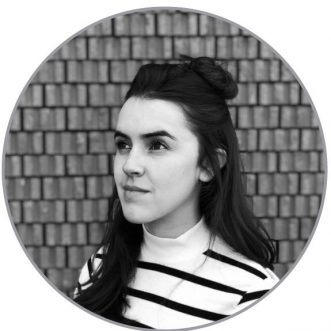
Camila Alvarez, Assistant
Architect from the Pontificia Universidad Javeriana in Bogotá, Colombia, and Master in Urban Planning and Policy Design from Politecnico di Milano in Italy. With special interests in the territorial planning, management, and governance of projects and efficient alternatives for the innovative development of the contemporary city. Her research master thesis was focused on the interpretation and critical theorization of governance through public transport. She has three years of experience in architectural projects, interior and urban design, urban planning and spatial analysis around several cities in Colombia, Italy, and France.
She has worked in various international competitions and workshops that have allowed her to develop transdisciplinary training and global experience cooperation. Currently, she is working in the Urban Sciences Lab as a researcher at the IaaC in Barcelona, Spain.
